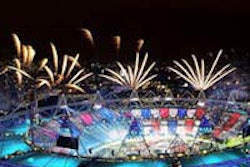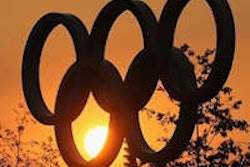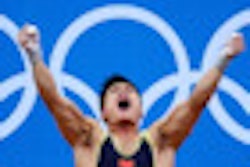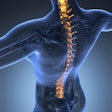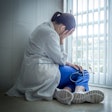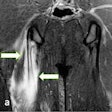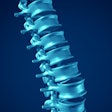
The Olympics radiology service proves that adversity can bring out the best in people. The overlay facilities were fitted at the last minute, leaving radiologists without air conditioning in a 3-meter-square reporting area, but, ironically, these challenges may well have been the making of the service, reflects Dr. Phil O'Connor, imaging lead for the games.
These tough conditions contributed to what he regarded as an unprecedented and remarkable camaraderie. "I was really surprised that my lasting memory of the games is the team spirit within the imaging team. I was really impressed and proud to have worked with them," said O'Connor, a consultant musculoskeletal radiologist from Leeds, U.K., in an exclusive interview with AuntMinnieEurope.com.
 Dr. Phil O'Connor enjoys a rare moment of relaxation with the Olympic Torch during the games. All images courtesy of Dr. O'Connor.
Dr. Phil O'Connor enjoys a rare moment of relaxation with the Olympic Torch during the games. All images courtesy of Dr. O'Connor.Amongst the team were many big names in the field, effectively a ‘Who's Who' of British musculoskeletal radiology, he added. "There were a lot of big personalities in the room, but they got on like a house on fire. Everybody left any baggage at the door, and I think some of this was actually down to the conditions being so ‘challenging.' "
Record number of scans
Facilities aside, the work was intense, but the service delivered admirably, O'Connor explained. The last of nearly 1,400 scans was completed at 9:45 on the evening of the closing ceremony. Each day started at 6:30 a.m. and finished at 11 p.m. There was no respite, making it effectively a four-week endurance event.
However, the service managed twice the number of scans as the Beijing Olympics in 2008. Early estimates show that the polyclinic carried out more than 1,600 examinations, of which 900 were MRI, 259 were x-ray, 400 were ultrasound, and 58 were CT.
Seven days during games time gave preference to pre- and in-competition athletes only. "It was a tightly prioritized and heavily utilized service," O'Connor said. In fact, it was testament to the quality of the service that 2012 was the first games that Team USA did not have its imaging second-reported in the U.S. "It's a great accolade for us that they chose to do this," he commented.
The standard of imaging equipment, supplied by GE Healthcare was central to this success. The polyclinic contained an estimated 7 million pounds (8.8 million euros) worth of imaging equipment, including a Discovery MR750w wide-bore 3-tesla MRI system, an Optima MR450w wide-bore 1.5-tesla MRI unit, a Discovery 750HD CT scanner, a Discovery XR656 wireless digital x-ray system, and Venue 40 and Logiq E9 ultrasound systems.
Leading the service from the GE perspective was Finn Crotty. O'Connor sings the praises of GE and Crotty, with good reason. "Finn was brilliant. Without him we would have struggled to deliver the service required. LOCOG [London Organising Committee of the Olympic and Paralympic Games] staff were really quite exhausted toward the midpoint and end of the games. Finn helped tremendously with shoring up any holes that developed in the service."
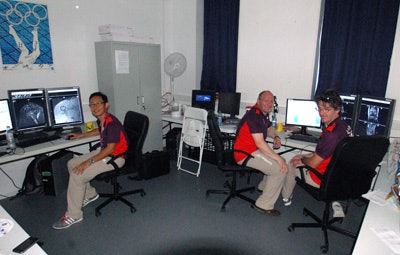 Radiologists and radiographers worked in fairly cramped conditions during the games, but they kept smiling.
Radiologists and radiographers worked in fairly cramped conditions during the games, but they kept smiling.Different to everyday practice
According to O'Connor, another notable reflection on the Olympic radiology service was how medical management of the athletes differed markedly from everyday practice. "Normally, we deal with a sportsperson with a five- to 10-year career plan --a footballer, for example -- but with these athletes, the Olympics is the pinnacle of their athletic achievements and they are thinking four weeks ahead maximum."
He added that because of this the Olympians were prepared to take a much higher level of risk in terms of their management decisions. "We experienced incredible injuries in athletes that went on to compete, because to them the games were so important. It was interesting that the greater the chance of winning a medal then the higher the risk the athlete was prepared to take."
Some athletes persisted only to break down in the event, but at other times their die-hard determination won out. O'Connor recalls that two injuries seen in the first four days of scanning, which under normal circumstances would usually mean the end of games for the athletes concerned, went on to complete the entire games program. The medical teams were incredibly skilled at balancing athlete expectation and the level of risk athletes faced.
Fighting your corner
Asked if he would do anything differently if he had his time again, O'Connor said he would do the same with respect to planning the service; however, he would pay closer attention to the local organizing committee's handling of budgetary pressures, which had major implications for the radiology service.
Facilities bore the brunt of the LOCOG cost-saving exercise. "Partition walls did not reach the ceiling so meetings were difficult. None of the furniture arrived, so I put the reporting room and reception together from scratch," he added.
So what of the all-important legacy? O'Connor said they carried out a number of studies gathering data on diagnostic and therapeutic impact, mainly on ultrasound and MRI. Every referrer filled in forms with differential diagnosis and diagnostic confidence, and the patient management plan. Postimaging, they revised these criteria. These data will be part of the International Olympic Committee report to be published at a later date.
With a view to Rio 2016, Brazil will source home-country radiologists, but there is a sense that O'Connor could quite happily do it all again. "It was one of the most exhausting experiences I have been through, but utterly fantastic at the same time," he concluded.
Furthermore, the Polyclinic looks certain to be a busy place right up to 9 September, when the Paralympics ends. The opening ceremony for the Paralympics takes place today.


